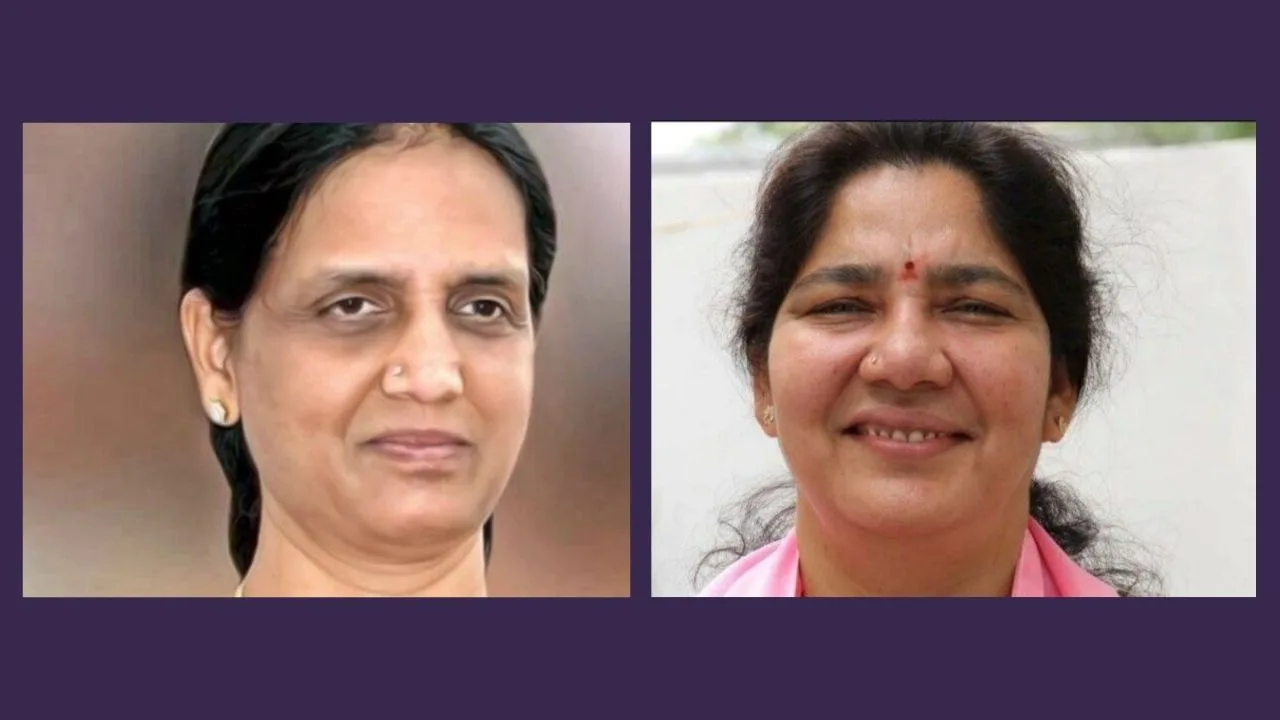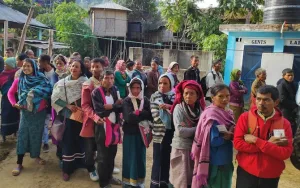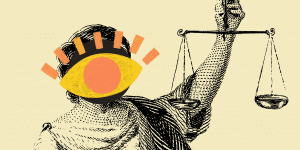Women Hold Fewer Ministerial Positions In State Governments

Telangana, the newest state in Southern India, finally has women ministers in the state’s council of ministers for the first time in its history. In a recent cabinet expansion, Chief Minister K Chandrashekhar Rao (KCR as he is popularly known) inducted P Sabitha Indra Reddy and Satyavathi Rathod as Education and Women and Child Development Ministers respectively.
In his first term soon after the state’s formation in 2014 and subsequently after his re-election in December 2018, KCR was criticised for appointing an all male cabinet. Despite women playing a pivotal role in the people’s movement for a separate Telangana state carved out of the erstwhile state of Andhra Pradesh, they were excluded from governance and decision making in the state’s polity.
Women now constitute 12% of Telangana’s council of ministers (CoM)- still a long way off from a minimum 33% reservation and upwards of 50%, that women in India have been advocating for, in various political and administrative institutions. Exclusion of women from the highest institutions of power, governance and decision-making across India is uniform across the country and systemic.
Of the 529 ministers across 28 states in India, only 41 are women- a mere 7.8%, according to a BehanBox analysis of countrywide data on women ministers. This is a marginal increase from 7% in 2015, when we carried out a similar analysis. Today, there is one woman Chief Minister- Mamata Banerjee in West Bengal in contrast to 3 in 2015. Women from marginalised communities- Scheduled castes, Tribes and Muslim women find fewer opportunities to hold power.
There are 7 states in the country with no women ministers in their council of ministers. Jharkhand (20%) has the highest and Bihar (3%) has the lowest proportion of women ministers in the state’s council of ministers.
Only 10 states in India have more than 10% women ministers
The dismal representation of women in ministerial councils is uniform across India. Only 10 of the 28 states ( excluding Jammu and Kashmir which has no Government currently) have more than 10% women in their state council of ministers. Jharkhand (20%), Tripura (14%) and Tamil Nadu (13%) are the states with the highest proportion of women ministers.
Among the states that have more than 20 ministers in their council of ministers, Tamil Nadu (13% ) has the highest proportion of women, followed by Andhra Pradesh (12%) and Odisha (10%).
Source: Data collated by Behanbox from various state government websites
[Image Description: A stacked bar chart showing the proportion of women ministers for states having more than 20 members in their CoM in descending order.
Tamil Nadu- 13%, AP- 12%, Odisha-10%, West Bengal-9%, Uttar Pradesh & MP-7%, Maharashtra and Gujarat-5%, Rajasthan-4% and Bihar 3%.]
For states with smaller council of ministers (less than 20), Jharkhand has the highest proportion with 20% women, followed by Tripura (14%) and Punjab (13%)
Source: Data collated by Behanbox from various state government websites
[Image Description: A stacked bar chart showing the proportion of women ministers for states having less than 20 members in their CoM in descending order.
Jharkhand- 20%, Punjab & Uttarakhand- 13%, Telangana-12%, Kerala & Himachal Pradesh-11%, Goa-9%, Chhattisgarh and Haryana-8%, Assam and Karnataka 6%.]
Women in cabinet positions are still inadequate
9 states- Haryana, Assam, Odisha, Maharashtra, Uttar Pradesh, Rajasthan, Gujarat, Uttarakhand and West Bengal- have a separate cabinet within the CoM. Cabinet ministers are senior ministers in the state’s council of ministers heading a department.
Haryana has the highest proportion where women form 13% of the 8 member cabinet, followed by Assam and Odisha which have 9% women.
Uttar Pradesh and Maharashtra which have a 24 member cabinet have mere 4% women. Rajasthan, Gujarat and Uttarakhand have no women with cabinet rank. In West Bengal, apart from Mamata Banerjee who is the chief minister and holds several ministries, there are no other women ministers in its 26 member cabinet.
Source: Data collated by Behanbox from various State Government Websites
[Image Description: A stacked bar chart showing the proportion of women minister with a cabinet rank in states with separate cabinets in descending order.
Haryana- 13%, Assam and Odisha- 9%, Maharashtra and UP-4%, Gujarat, Rajasthan, UP & West Bengal -0%]
Delhi and 6 other states have no women in their council of ministers
It is 2019 and there are still states within India that have no women in their council of ministers. The Government of National Capital Territory of Delhi headed by Arvind Kejriwal is one of them. Other states that do not have women ministers are Sikkim, Arunachal Pradesh, Manipur, Mizoram, Nagaland and Meghalaya- all in North East India. The union territory of Puducherry has no women ministers either.
Women ministers still kept away from ministries other than women and child welfare
In most states where women do find a place in the council of ministers, they are mostly in charge of the Women and Child welfare department (WCD)- a key ministry for conceiving and implementing policies for women and children in the states. 14 of the 41 women ministers across India hold the WCD portfolio.
Maharashtra which has only 2 women ministers in its 42 member ministry- Pankaja Munde with a cabinet rank and Vidya Jaiprakash Thakur( Minister of State) are both part of the WCD.
However, state administrations are not inducting enough women to head other important ministries.
Andhra Pradesh is the only state which has a woman deputy chief minister from the Scheduled Tribe community- Pamula Pushpa Srivani. It is also the only state where a woman, Mekathoti Sucharitha, from the Scheduled Caste community holds the Home portfolio apart from West Bengal where the chief minister Mamata Banerjee is in charge of Home and Hill Affairs department. United AP had a woman Home minister earlier when the former chief minister Y.S.Rajashekhar Reddy appointed P Sabitha Indra Reddy- the current education minister of Telangana- to head the department in 2009.
Some other notable exceptions where women hold portfolios others than WCD are Tamil Nadu and Telangana where Razia Sultana and Sabitha Reddy head Education respectively, Jharkhand where Dr. Louise Marandi is in-charge of Human Resource Development and Goa where Jennifer Monserrate heads the Revenue department.
Kerala is the only state with a woman health minister- KK Shailaja Teacher, who steered the state through the Nipah virus crisis.
Among the 4 women ministers in UP, 3 of them are involved in various aspects of education. Kamala Rani Varun is heads the Technical Education department with a cabinet rank while
Gulab Devi and Neelima Katiyar are state ministers in the Higher and Secondary education departments.
Fewer women ministers from marginalised communities
Of the 41 women ministers, BehanBox was able to identify only 6 women ministers each belonging to the Scheduled castes and Scheduled Tribes (ST) communities based on their constituencies.
Those from the ST communities are Pramila Rani Brahma (Assam), Pamula Pushpa Srivani (Andhra Pradesh), Dr. Louise Marandi (Jharkhand), Padmini Dian (Odisha), Sandhya Rani Tudu (West Bengal) and Satyavathi Rathod (Telangana).
Mekathoti Sucharita( Andhra Pradesh), Imarti Devi (Madhya Pradesh), T Rajya Laksmi (Tamil Nadu), Rekha Arya (Uttarakhand), Asima Patra (West Bengal) and Mamta Bhupesh (Rajasthan) belong to the SC communities.
Only 3 Muslim women hold ministerial berths across India- Razia Sultana (Punjab), Nilofer Kafeel and Razia Sultana (Tamil Nadu).
A full list of women ministers in different states is below:
Table: Full list of women ministers in all states
| State | Name of the Woman Minister | Rank | Portfolio |
|---|---|---|---|
| Andhra Pradesh | Pamula Pushpa Srivani | Cabinet Minister | Deputy Chief Minister Minister of Tribal Welfare |
| Andhra Pradesh | Taneti Vanitha | Cabinet Minister | Women and Child Welfare Minister |
| Andhra Pradesh | Mekathoti Sucharitha | Cabinet Minister | Home Disaster Management |
| Assam | Pramila Rani Brahma | Cabinet Minister | Social Welfare Soil Conservation |
| Bihar | Bima Bharati | Cabinet Minister | Sugarcane Department |
| Chhattisgarh | Anila Bhediya | Cabinet Minister | Women & Child Development Social Welfare |
| Goa | Jennifer Monserrate | Cabinet Minister | Revenue Information & Technology Labour & Employment |
| Gujarat | Vibhavariben Vijaybhai Dave | Minister of State | Women and Child Welfare Education(Primary and Higher Education) Pilgrimage |
| Haryana | Kavita Jain | Cabinet Minister | Art & Cultural Affairs Women & Child Development Urban Local Bodies Information, Public Relations & Languages |
| Himachal Pradesh | Sarveen Chaudhary | Cabinet Minister | Urban Development Minister |
| Jharkhand | Neera Yadav | Cabinet Minister | women and child |
| Jharkhand | Louise Marandi | Cabinet Minister | HRD |
| Karnataka | Jolle Shashikala Annasaheb | Cabinet Minister | Women and Child Development Empowerment of differently Abled and Senior Citizens |
| Kerala | Mercy Kutty Amma | Cabinet Minister | Minister for Fisheries Harbour Engineering Traditional Industries |
| Kerala | KK Shailaja Teacher | Cabinet Minister | Minister of Health Social Justice |
| Madhya Pradesh | Imarti Devi | Cabinet Minister | Women and Child Development |
| Madhya Pradesh | Vijaylakshmi Sadho | Cabinet Minister | Culture Department Medical Education Ayush Department |
| Maharashtra | Pankaja Munde | Cabinet Minister | Women and Child Development |
| Maharashtra | Vidya Jaiprakash Thakur | Minister of State | women and child welfare |
| Odisha | Tukuni Sahu | Cabinet Minister | Women & Child Development & (Mission Shakti) |
| Odisha | Padmini Dian | Minister of State | Textiles, Handlooms & Handicrafts |
| Punjab | Aruna Chaudhary | Cabinet Minister | Social Security Women & Child Development |
| Punjab | Razia Sultana | Cabinet Minister | Water Supply & Sanitation (Public Health) Transport |
| Rajasthan | Mamta Bhupesh | Minister of State | Women and Child Development Dept. (Independent Charge) Public Grievances Redressal Dept. Minority Affairs Dept. Waqf Dept. |
| Tamil Nadu | T.Rajyalakshmi | Cabinet Minister | Minister for Adi Dravidar and Tribal Welfare |
| Tamil Nadu | Razia Sultana | Cabinet Minister | Water Higher education |
| Tamil Nadu | Nilofer Kafeel | Cabinet Minister | Minister for labour |
| Tamil Nadu | V Saroja | Cabinet Minister | Minister for Social Welfare Nutritious Noon Meal Programme |
| Tamil Nadu | S Valarmathi | Cabinet Minister | Minister for Backward Classes and Minorities Welfare |
| Telangana | Sabitha Indra Reddy | Cabinet Minister | Education |
| Telangana | Satyavathi Rathod | Cabinet Minister | ST Welfare Women & Child Welfare |
| Tripura | Santana Chakma | Cabinet Minister | Social Welfare & Social Education Animal Resource Development |
| Uttar Pradesh | Kamala Rani Varun | Cabinet Minister | Technical Education |
| Uttar Pradesh | Swati Singh | Minister of State | Women’s Welfare, Child Development Nutrition(MOS) |
| Uttar Pradesh | Neelima Katiyar | Minister of State | Higher Education Science and Technology |
| Uttar Pradesh | Gulab Devi | Minister of State | Secondary Education |
| Uttarakhand | Rekha Arya | Minister of State | Women’s Welfare & Child Development Animal Husbandry Sheep & Goat Rearing Fodder & Pastoral Development Fishery Development |
| West Bengal | Sandhya Rani Tudu | Minister of State | Backward Classes Welfare |
| West Bengal | Ashima Patra | Minister of State | Backward Classes Welfare |
| West Bengal | Chandrima Bhattacharya | Minister of State | Housing (Independent Charge) & Panchayats and Rural Development Health and Familly Walfare Land and Land Reforms & Refugee Relief and Rehabilitation |
| West Bengal | Ratna Kar Ghosh | Minister of State | Micro, Small & Medium Enterprises & Textiles (Excluding Textiles and Handloom) |
Source: Data collated by Behanbox from various State Government Websites
We believe everyone deserves equal access to accurate news. Support from our readers enables us to keep our journalism open and free for everyone, all over the world.




